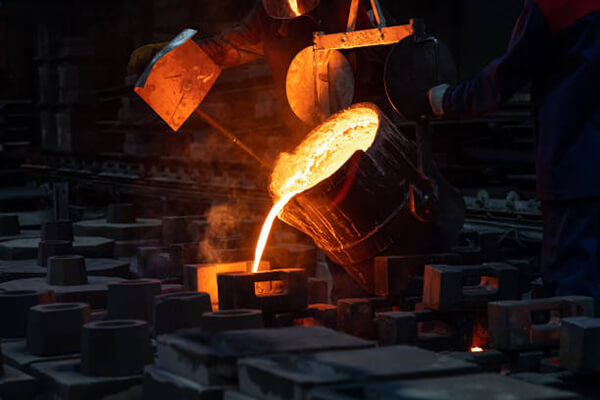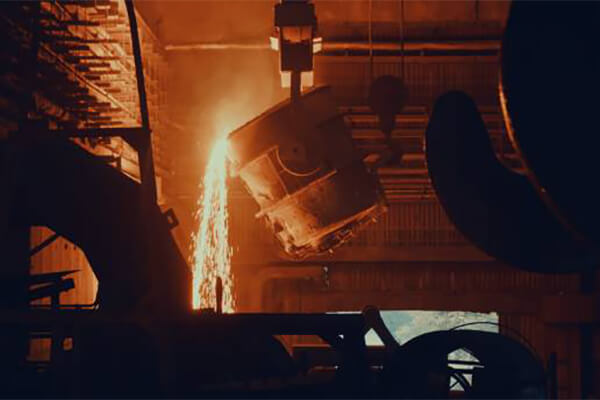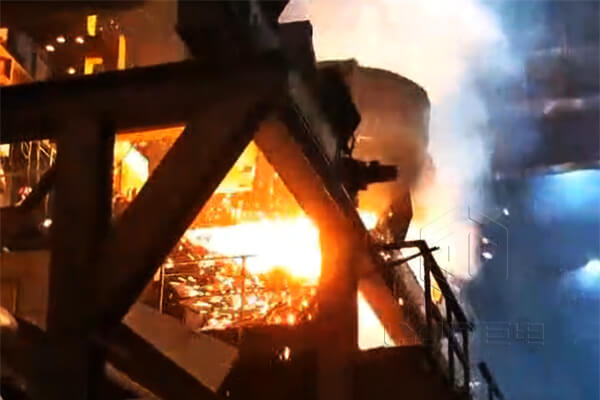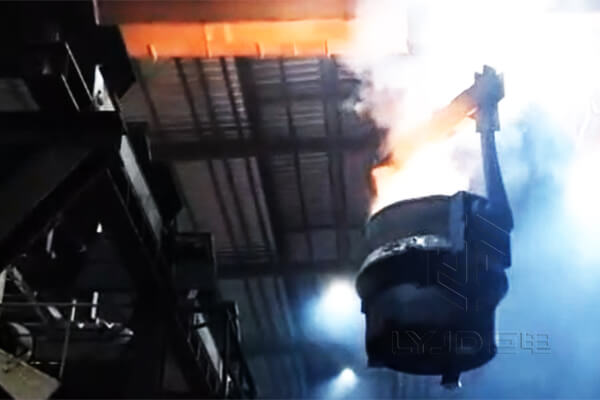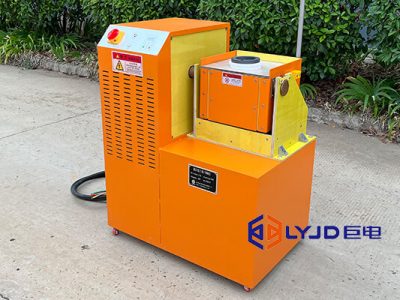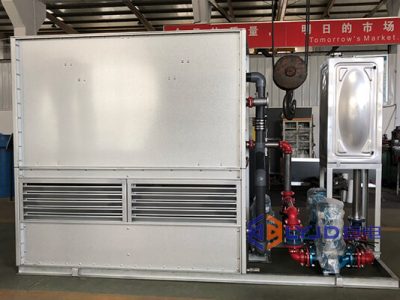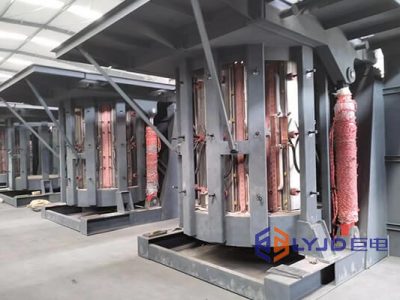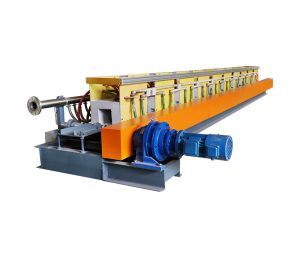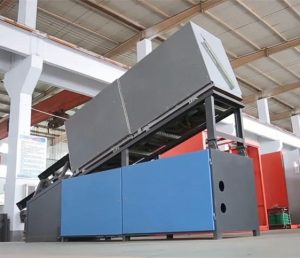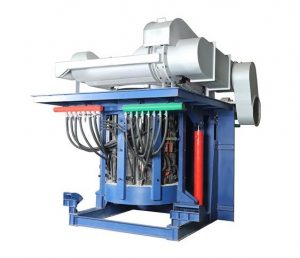An induction foundry furnace, also known as an induction melting furnace or induction furnace, is a type of furnace for melting and heating metals using the principle of electromagnetic induction. In foundries and metalworking industries, induction foundry furnaces play an important role in various applications, including casting, alloying, and heat treatment.
How Does an Induction Foundry Furnace Work?
Principle of Electromagnetic Induction
The furnace utilizes the principle of electromagnetic induction, which states that a changing magnetic field induces an electric current in a conductor. In this case, the conductor is the metal being melted or heated.
Induction Coil
The furnace consists of a coil made of copper or other conductive material. The coil is energized with alternating current (AC), typically at high frequencies ranging from a few hundred to several thousand hertz. The AC flowing through the coil generates a rapidly alternating magnetic field.
Eddy Currents
When a conductive material, such as a metal, is placed within the alternating magnetic field, it experiences a phenomenon called eddy currents. These are circulating currents induced within the metal due to the changing magnetic field.
Heating Process
The eddy currents generated within the metal oppose the magnetic field that created them. As a result, the metal offers resistance to the flow of eddy currents, and this resistance leads to the generation of heat. The heat is concentrated near the surface of the metal, causing it to rapidly heat up.
Melting and Heating
As the metal heats up, it gradually reaches its melting point, leading to its transformation from solid to liquid state. The temperature and timing can be precisely controlled to achieve the desired melting or heating process.
Crucible or Induction Furnace Lining
The metal is usually contained within a crucible made of a refractory material that can withstand high temperatures. Alternatively, in some induction furnaces, the lining of the furnace itself can act as the crucible.
Other Furnace Components
Induction foundry furnaces may also include additional components such as power supplies, cooling systems, temperature monitoring devices, and controls for regulating the power input and process parameters.
Advantages of Induction Foundry Furnace
Induction foundry furnaces offer several advantages over other types of furnaces used in metal melting and heating processes. Here are some of the key advantages.
High Efficiency
Induction furnaces are highly efficient in converting electrical energy into heat energy. The use of electromagnetic induction allows for direct and rapid heating of the metal, minimizing energy losses. Compared to traditional furnaces like gas-fired or oil-fired furnaces, induction furnaces have higher energy efficiency and lower operating costs.
Fast Heating
Induction furnaces can achieve rapid and uniform heating of the metal. The electromagnetic induction process generates heat directly within the metal, leading to quick and efficient melting or heating. This can result in shorter process cycles and increased productivity.
Precise Temperature Control
Induction furnaces provide precise temperature control, allowing for accurate heating and melting of metals. The power input to the induction coil can be easily regulated, enabling fine-tuning of the temperature profile. This level of control is particularly important for applications that require specific temperature ranges or heat treatment processes.
Clean and Environmentally Friendly
Induction furnaces operate without the need for combustion, eliminating the release of harmful emissions such as greenhouse gases, particulate matter, and volatile organic compounds. They do not produce smoke, soot, or ash, resulting in a cleaner and healthier working environment. Additionally, induction furnaces do not require the use of fossil fuels, reducing dependence on non-renewable energy sources.
Versatility
Induction furnaces are versatile and can be used for melting and heating a wide range of metals, including ferrous and non-ferrous alloys. They can handle various sizes and shapes of metal parts, making them suitable for diverse applications in foundries, metalworking shops, and manufacturing industries.
Controllability and Automation
Induction furnaces can be easily integrated into automated systems for improved process control and efficiency. They can be equipped with advanced control systems and monitoring devices to ensure precise temperature control, power regulation, and process automation. This allows for consistent and repeatable results, reducing human error and ensuring product quality.
Safety
Induction furnaces provide a safer working environment compared to traditional fuel-fired furnaces. Since there is no open flame or fuel combustion, the risk of fire or explosions is significantly reduced. Induction furnaces also have built-in safety features such as temperature sensors, emergency shut-off systems, and controlled cooling mechanisms.
Applications of Induction Foundry Furnace
Induction foundry furnaces have a wide range of applications in the foundry and metalworking industries. Here are some common applications.
Metal Melting
Induction furnaces are extensively used for melting various types of metals, including iron, steel, aluminum, copper, brass, and bronze. They can handle both ferrous and non-ferrous alloys. Metal melting is a fundamental process in foundries for casting and producing metal components.
Casting and Foundry Operations
Induction furnaces are utilized in foundries for casting operations. Molten metal from the furnace is poured into molds to create castings of desired shapes and sizes. Induction furnaces are often preferred for casting processes due to their fast heating capabilities, precise temperature control, and ability to melt a wide range of metals.
Alloying and Metal Composition Adjustments
Induction furnaces are used for alloying processes where different metals or elements are combined to create specific alloys with desired properties. The precise temperature control and uniform heating provided by induction furnaces enable accurate composition adjustments and consistent alloy quality.
Heat Treatment
Induction furnaces are employed in heat treatment processes such as annealing, tempering, and hardening. These processes involve controlled heating and cooling of metals to alter their physical and mechanical properties. Induction furnaces offer precise temperature control, fast heating rates, and uniform heating, making them suitable for heat treatment applications.
Induction furnaces are used for reheating previously cast or formed metal parts before subsequent processing operations like forging, rolling, or extrusion. The rapid and efficient heating provided by induction furnaces ensures consistent and controlled reheating of the metal for subsequent shaping or forming processes.
Scrap Metal Recycling
Induction furnaces play a crucial role in the recycling of scrap metal. They can efficiently melt and process various types of scrap metal, allowing for the recovery and reuse of valuable metals. Induction furnaces are particularly useful in recycling applications due to their ability to quickly melt and separate different alloys and metals.
Laboratory and Research Applications
Induction furnaces find applications in research laboratories, universities, and specialized facilities for metallurgical research, alloy development, and material testing. They provide precise temperature control, controlled atmosphere options, and efficient melting capabilities for small-scale experimental or analytical processes.
Operation Guideline of Induction Foundry Furnace
Operating an induction foundry furnace requires careful attention to safety and proper procedure. While specific guidelines may vary depending on the furnace model and manufacturer, here are some general operating guidelines for an induction foundry furnace.
Familiarize yourself with the furnace
Read and understand the manufacturer's operating manual and safety guidelines specific to your induction foundry furnace. Be aware of the furnace's features, controls, and safety mechanisms before operation.
Personal protective equipment (PPE)
Wear appropriate PPE, including heat-resistant gloves, safety glasses or goggles, heat-resistant clothing, and any other necessary protective gear. Ensure that all operators and personnel in the vicinity of the furnace are wearing suitable PPE.
Safety checks
Before starting the furnace, conduct a visual inspection of the equipment to ensure that all components are in good condition. Check for any signs of damage, loose connections, or abnormalities. Verify that emergency shutdown controls are easily accessible and functional.
Power supply
Ensure that the power supply to the furnace is properly connected and within the specified voltage and frequency range. Follow the manufacturer's instructions for electrical connections and power requirements.
Crucible preparation
If using a crucible, ensure that it is clean, dry, and securely positioned within the furnace. Properly align the crucible within the furnace to ensure efficient heating and melting.
Load the material
Place the metal or material to be melted or heated into the crucible or directly into the furnace, following the recommended maximum weight and capacity limits specified by the manufacturer. Take care to distribute the material evenly and avoid overloading the furnace.
Close the furnace
Ensure that the furnace lid or cover is securely closed to prevent heat loss and potential hazards. Follow the manufacturer's instructions for sealing and securing the furnace.
Set operating parameters
Use the furnace controls to set the desired operating parameters, such as power input, temperature, and heating time. Follow the manufacturer's guidelines for the specific metal or material being processed. Exercise caution when adjusting the parameters to avoid overheating or causing thermal stress.
Start the heating process
Initiate the heating process according to the furnace's operating controls. Monitor the temperature and heating progress closely, adhering to the recommended heating rate and temperature profile for the material being processed.
Monitor the process
Continuously monitor the furnace operation, paying attention to temperature, power supply, and any warning indicators or alarms. Observe the melting or heating progress and make necessary adjustments to the operating parameters as required.
Shutdown and cooldown
Once the desired melting or heating process is complete, follow the manufacturer's instructions for safely shutting down the furnace. Allow sufficient time for the furnace and crucible to cool down before opening or handling them.
Maintenance and cleaning
Regularly inspect and maintain the furnace according to the manufacturer's recommendations. Clean the interior and exterior of the furnace as needed, following appropriate procedures and using suitable cleaning agents.
At Last
Luoyang Judian is a professional manufacturer of induction foundry furnaces in China. We have more than 20 years of experience in the industry. Welcome to contact us if you have other questions about the induction foundry furnace.
























